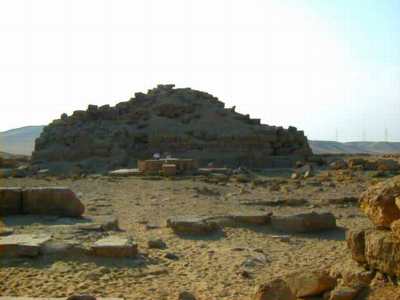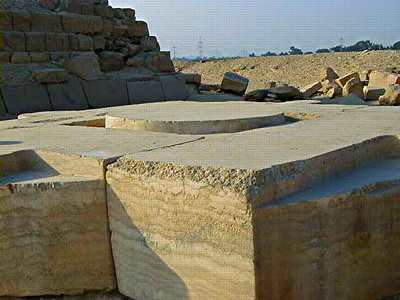

Immediately north of Saqqara lies the principal necropolis of the Dynasty V kings: Abusir. The modern name,"Abusir," is derived -- via Greek -- from an Egyptian term meaning "House of Osiris." Osiris, of course, was lord of the underworld. The place, Abusir, may not have been differentiated in ancient times from Saqqara, a surmise that seems reasonable enough when the visitor looks to the south and is able clearly to see the Step Pyramid.
The Abusir pyramids, like those of their predecessors, were outfitted with mortuary temples (situated on the eastern side) and valley temples connected by causeways. The Sahure complex was particularly influential on the design of later 5th-dynasty pyramids and related temples.
Arguably, however, the most significant contribution to ancient Egyptian religious, and thus social, development by the Dynasty V kings was their dedication to and identification with the sun god, Re (or Ra; I've chosen to use Re for no particular reason). The first king of the dynasty, Userkaf, built his pyramid at Saqqara, but in addition he constructed a "Sun Temple" located adjacent to the later pyramids at Abusir. One of only two such temples so far discovered (though others are known to have existed), the Sun Temple was open to the sun but consisted, like the pyramid complexes, of a valley temple connected by a causeway to an upper temple, the centerpiece of which was an obelisk, symbolizing Re, placed on a truncated pyramid.
The other excavated Sun Temple, that of Niuserre, is more complete and most easily available to visitors of the two. The obelisk, obviously, is long gone but the huge pedestal upon which it sat is there to be climbed by irreverent visitors and the altar in the court beside it is in remarkable shape after all these centuries. Like pyramid mortuary temples, Sun Temples were equipped with cult trappings, including priesthoods. Since these kings identified with the sun god, in a real sense the obelisk, the altar, and (at least in the case of the Niuserre temple) the solar boat were there to link the king with Re after death no less than during his reign.
 |  |